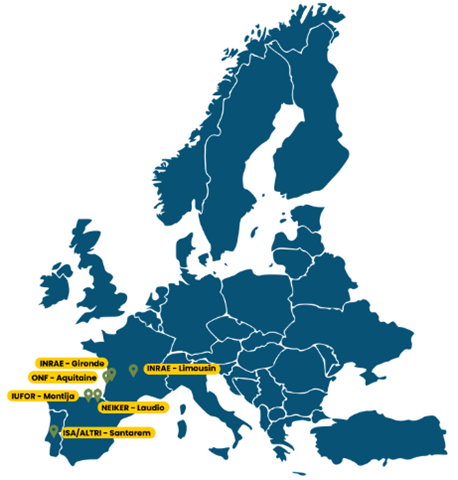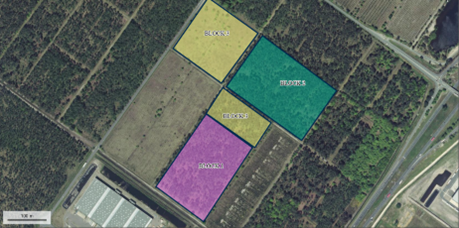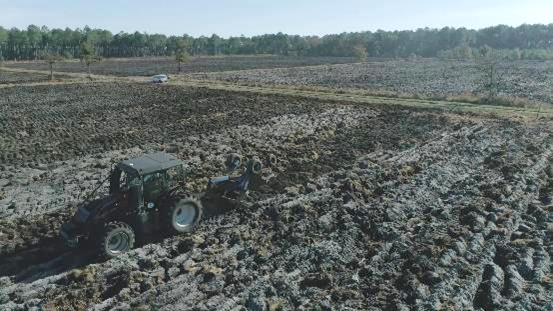FORMIX (France, Spain, Portugal)
The FORMIX network of tree diversity experiments has been set up in south-western Europe but is intended to be extended to other regions of the globe. The first five experiments were established in Portugal (1), Spain (2) and France (2) in 2022 and 2023. Seven demonstration trials have been also set up by the French National Forest Office in the Aquitaine region. The main objectives are twofold. From a scientific point of view, the aim is to contribute to a better understanding of the relationships between tree diversity and the multifunctionality of forests. From a more applied point of view, the aim is to provide forest owners and practitioners with operational options for mixed-species plantations, based on the mixing of a few tree species of interest to the regional forestry sector, in spatial designs that allow for the mechanization of stand management.

Design
The FORMIX experiments generally consists of 3 to 4 blocks, with all treatments in each block, in randomized position. Species richness levels are 1, 2, and 3, sometimes 4, with all species in the mixtures also planted as monocultures. In most experiments several planting densities and species proportion are tested for each composition. Tree species are mixed in alternating monospecific rows, i.e. in a row-wise intermingling pattern.

! vreemde caption van figuur
Site characteristics
FORMIX is coordinated by Hervé Jactel and managed by Benoît de Guerry. The table with the overview of the different FORMIX sites is under development.
| FORMIX-INRAE (Gironde) | FORMIX-INRAE (Limousin) | FORMIX-NEIKER (Laudio) | FORMIX-UAV (Montija) | FORMIX-ISA (Santarem) | |
|---|---|---|---|---|---|
| Country | France | France | Spain | Spain | Portugal |
| Biome | temperate | temperate | |||
| Latitude | 44.72 | 45.63 | |||
| Longitude | -0.75 | 2.14 | |||
| Soil type | Podzols (site class: Humid moor-lands) | Podzoluvisols | |||
| Altitude | 62 m | 850 m | |||
| Design | row wise regular | row wise regular | |||
| Plot shape | rectangular | rectangular | |||
| Plot size (m^2) | to be completed | to be completed | to be completed | to be completed | to be completed |
| Plant distance (m) | 2 densities: 4 (in row) x 1.5 m (between) (1666 t/ha) or 4 (in row) x 2m (between) (1250 t/ha) | 2 densities: 3 (in row) x 2 m (between) (1666 t/ha) or 3 (in row) x 2.67m (between) (1250 t/ha) | |||
| Size species pool | 6 | 4 | 3 | 3 | 3 |
| Species pool | Pinus pinaster Pinus taeda Pinus pinea Betula pendula Quercus rubra Quercus ilex |
Pseudotsuga menziesii Larix eurolepis Betula pendula Quercus rubra |
Larix marschlinsii Quercus petraea Alnus cordata |
Pinus sylvestris Pinus nigra Betula pendula |
Eucalyptus globulus Cupressus sempervirens Arbutus unedo |
| Contact person | Céline Meredieu | Céline Meredieu | Ander Arias Gonzalez | Felipe Bravo Oviedo | Susana Barreiro Luis Fontes |
| 20celine.meredieu@inrea.fr | 20celine.meredieu@inrea.fr | agonzalez@neiker.eus | felipe.bravo@uva.es | smb@isa.ulisboa.pt |
Research
The first main scientific objective will be to better analyse the effect of tree species composition, proportion and density in mixed plantations on several key ecosystem functions such as seedling survival, tree growth and stand productivity, above and below ground carbon sequestration, resistance and resilience to abiotic (drought, heat waves) and biotic (pests and pathogens) disturbances. The second main objective is to use these experiments as demonstration sites to better understand how to meet stakeholder expectations regarding the development of mixed species plantations, taking into account technical and economic constraints and societal perception.
Extra information
Send an e-mail to the contact person, or visit the website of the FORMIX network.
Research papers
- This experiment is working hard on the first international publications

